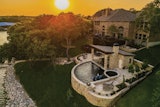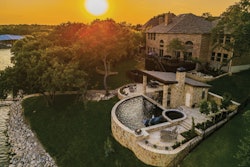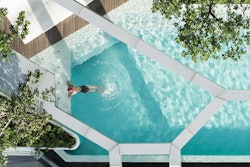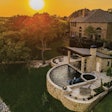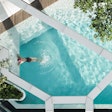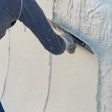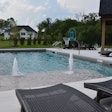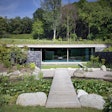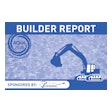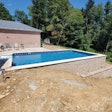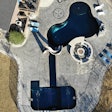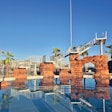
Options range from concrete to wood to pavers to stone to composite products, but no matter the material, a deck and pool go together like baseball and hot dogs. You can hardly enjoy one without the other.
Choosing the right combination makes all the difference.
"There are a million different ways to install and pick [decking] materials out for patios," says Jamie Ori, president of Rosebrook Pools in Libertyville, Ill. "Limitations are mainly budget and what the client is using the pool for."
Here is a brief rundown of some of the popular decking materials, focusing on price point, safety, longevity/durability and aesthetics.
Concrete
Concrete decking is available in a variety of surface textures: plain, broom, stamped. As one of the more popular choices on the market, concrete gives clients the options of "dressing up" a standard finish (broom or stamped) or keeping things minimal or classic (plain).
Price Point
The variance between concrete finish price points depends on the type of concrete the client wants. According to Keith Hoskins, president of Olympia Pools & Spas in Fort Wayne, Ind., stamped concrete is running $10 per square foot while broom is $5.50 per square foot in his area.
Nearly half the jobs Niagara Pools & Spas has completed recently feature a plain concrete deck while patterned or stamped concrete surrounds another 35 percent of the pools, says Kenneth Smith, owner of the Blackwood, N.J., company. "In this area, plain concrete is running $5.50 to $6.50 a square foot," says Smith, and "depending on who the contractor is and what the job is, patterned or stamped concrete is $11 to $12 a square foot in the area."
Safety
"Assuming that it's put down on a flat surface," says Smith, "patterned concrete can have a safety issue if the sealers aren't applied correctly - if they put too much sealer on and don't put a non-skid product in it." He notes that water-based sealers are less prone to slippery surfaces.
Longevity/Durability
Concrete is going to crack over time, says Hoskins, but that's not the main issue affecting its longevity. It's a rare occurrence to witness cracking severe enough to require replacement.
"Longevity is more of a cosmetic issue, just like somebody redecorating your bathroom," says Hoskins. "You get tired of what you have so you want something different. Typically, the concrete is going to last forever. You'll get a crack or two in it that does not follow the control joints every once and awhile."
Periodically resealing the concrete helps to maintain its durability. "You just can't take a seal job and not reseal it after three or four or five years," says Smith. Not only does resealing help the concrete keep its strong surface, it also helps keep its depth and color.
"What you are sealing it from is first the elements, not your chemicals. I mean everybody is going to spill chlorine or something around the skimmer. The staining really comes in over the winter, at least in the Northeast, where the pools are opened all the time. You have a lot of deciduous trees, they rot, they are jammed up against the covers and the springs, and that's where you get a lot of the staining."
On top of resealing the concrete, Ori suggests deep cleaning the deck each year and using a degreaser like trisodium phosphate, as well as acid to clean the surface and keep up its appearance.
Aesthetics
When you are putting in a pool, it doesn't matter how much money is invested or how beautiful the project looks if the deck doesn't live up to the same standards.
"Aesthetics have a lot to do with the contractor and what his creativity is, as well as what clients are willing to pay to get a job done," says Smith. "Patterned concrete is pretty cool because you get some pretty unique patterns with it and colors you can change."
When a client chooses the color of the concrete, it's integrated during the initial mixing stage, and won't fade over time like a topical color job. Accent colors can also be applied, giving homeowners another variation of color that pops throughout the pattern.
Hoskins also provides an acrylic-resurfacing product for clients who want to make simple cosmetic changes to the deck.
"You can apply different textures, Blackstone or brick design," adds Hoskins. "The acrylic really bonds to the existing surface, but it may be a little more receptive to damage from the patio furniture being dragged across it or something because it's only 18-inch thick. It costs anywhere from $4 to $7 a square foot, depending on how intricate they want it."
Wood
Wood decking tends to be a more regional trend, and one that really isn't a popular choice around inground pools these days. You're most likely to find a wood deck when there are specific building constraints, or on an aboveground pool.
"We mainly do [wood decking] in areas where there are big elevation drops and in city areas," says Ori. "I don't think it was ever really popular, unless it was a custom pool, a custom situation, a custom backyard."
Price Point
There are a variety of woods available for homeowners. Composite wood is more expensive than cedar, notes Ori, but recycled wood is more expensive than composite. For a custom pool with a steep elevation, this may be the perfect fit, but for aboveground pools, it may be altogether too expensive.
"Wood is still being done around aboveground pools," says Hoskins, "but because of the expense of it, not many people do it. Most people who buy an aboveground pool are not looking to spend $15,000 to $30,000 for a pool. They are looking to get a nice pool for the family in the backyard at a more reasonable cost. When you start adding decking, a lot of times the deck costs more than the pool does."
Safety
Ori notes that wood tends to be a very slippery deck surface when wet, so it may not be the best choice around a pool.
Clients should also be aware that when installed correctly and properly cared for, the likelihood is less, but wood does splinter, leaving feet vulnerable to jagged spots.
"That's mainly from poor installation, or if something is really old and it's rotting out," says Ori. "As long as it's maintained, splinters should never happen."
Longevity/Durability
Routine maintenance includes treating the deck each year and replacing planks when necessary. Hoskins suggests treating the wood with a preservative and a sealer, but notes that is not a fix-all for wood decks.
Aesthetics
Because of the variety of wood species available, wood decking has some very appealing looks. However, the newer composite wood decking available leaves clients with few options to choose from.
"Composite decking is pretty much a no-maintenance, great product," says Ori. "It comes with a lifetime warranty, easy to install. The only thing is there is not much flexibility with aesthetics. It is kind of set. You have certain samples and certain colors, and that's what you have to choose from."
The materials available to homeowners in regards to natural stone seem endless. Flagstone, travertine, sandstone, bluestone. When choosing this deck finish, it really will depend on what specific look the client is looking for and how much they are willing to invest.
Price Point
Natural stone will almost always be the priciest decking option, simply because of the costs associated with quarrying it and transporting it to a job site.
"There's a huge labor cost to get the material," says Ori. "It's pulled out of the side of mountains rather than controlled in a factory. Those price points are going to be among the highest."
Safety
Ori suggests "flaming" the stone in an effort to make it non-slip. "What that means is the material is heated up, and it allows the top surface of it to pop, almost as if it was sandblasted. It's not rough, but it's roughed to a point where if it gets wet, somebody's not going to walk across it and slip."
He also tries to stay away from polished or honed materials because the process makes the stone slick.
Longevity/Durability
Stone placement and setting plays a huge role in its longevity. "We can pour a concrete slab underneath it and mortar the stones down and grout them. Or we can set them dry on gravel and sand," says Ori. "There are pros and cons to both.
"The beauty of putting natural stone on a concrete slab is you're not going to get as much settlement or movement as when it's set dry."
The elements can wreak havoc on a dry setting, allowing water to seep into the stones and shift their placement, which could be a good thing, says Ori.
"If there is movement, you can lift them up, throw some sand around and make them look good again. If it's set on concrete and a crack runs through the stone, you have to pop that stone up and put a new stone in there.
"Depending on the type of maintenance you do to it, it will always look the way it was installed unless you let it go."
Ori says staining is possible, depending on the type and density of the stone. Softer stones are likelier to take more abuse than harder stones, especially in certain climates and regions of the United States.
Aesthetics
Stone has the ability to create a variety of looks. Different finish options can bring about different colorings and a change in veins.
"We go over all these choices with a client and really go through a very detailed process in picking what they want," says Ori. "You can get six different colors of bluestone and you can get six different finishes of bluestone and then you can set that bluestone six different ways."
Paying attention to what is around the poolscape - natural waterfalls or large boulders - also helps decide what stone is the best fit.
"Some people want contemporary and some people want real natural," adds Ori, noting that some even enjoy the look of moss growing on the stones.
Final Decision
With the number of deck finishes on the market, it can be overwhelming for a client to settle on the one that makes the backyard beautiful. But when the decision is made and the project finished, the deck not only supports the pool, it complements it.
"When somebody walks in the backyard, the first thing they see besides the water in the pool is what's around it," says Ori. "It's the patio. We do patios that are three times as much as the pools we are putting in the ground. Only 50 percent of the time are people in the pool. They are enjoying the space on the patio."


















